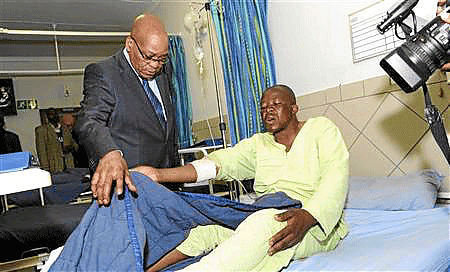
The police killing of 34 striking platinum miners in the bloodiest security operation since the end of white rule cut to the quick of South Africa’s psyche on Friday, with searching questions asked of its post-apartheid soul.
Newspaper headlines screamed “Bloodbath”, “Killing Field” and “Mine Slaughter”, with graphic photographs of heavily armed white and black police officers walking casually past the bloodied corpses of black men lying crumpled in the dust.
The images, along with television footage of a phalanx of officers opening up with automatic weapons on a small group of men in blankets and t-shirts, rekindled uncomfortable memories of South Africa’s racist past.
Police chief, Riah Phiyega, confirmed 34 dead and 78 injured after officers moved in against 3 000 striking drill operators armed with machetes and sticks and massed on a rocky outcrop at the mine, 100km northwest of Johannesburg. Phiyega, a former banking executive who was only appointed to lead the police force in June, said officers had acted in self-defence against charging, armed assailants at Lonmin’s Marikana platinum plant.
“The police members had to employ force to protect themselves from the charging group,” she told a news conference, noting that two policemen had been hacked to death by a mob at the mine on Tuesday last week.
However, the South African Institute of Race relations likened the incident to the 1960 Sharpeville township massacre near Johannesburg, when apartheid police opened fire on a crowd of black protesters, killing more than 50.
“Obviously the issues that have led to this are not the same as the past, but the response and the outcome is very similar,” research manager, Lucy Holborn said.
- Chamisa under fire over US$120K donation
- Mavhunga puts DeMbare into Chibuku quarterfinals
- Pension funds bet on Cabora Bassa oilfields
- Councils defy govt fire tender directive
Keep Reading
In a front page editorial, the Sowetan newspaper questioned what had changed since 1994, when Nelson Mandela overturned three centuries of white domination to become South Africa’s first black president.
“It has happened in this country before where the apartheid regime treated black people like objects,” the paper, named after South Africa’s biggest black township, said.
“It is continuing in a different guise now.”
President Jacob Zuma cut short a visit to a regional summit in neighbouring Mozambique to head to the mine. Zuma, who faces an internal leadership election in his ruling African National Congress (ANC) in December, said he was “shocked and dismayed” at the violence, but made no comment on the police behaviour.
“We believe there is enough space in our democratic order for any dispute to be resolved through dialogue without any breaches of the law or violence,” he said in a statement.
Despite promises of a better life for all South Africa’s 50 million people, the ANC has struggled to provide basic services to millions in poor black townships.
Efforts to redress the economic inequalities of apartheid have had mixed results, and the mining sector comes in for particular criticism from radical ANC factions as a bastion of “white monopoly capital”.
As dawn broke, hundreds of police patrolled the dusty plains around the Marikana mine, which was forced to shut down last week because of a rumbling union turf war that has hit the platinum sector this year.
Workers’ unions blamed for sparking violence
Although the striking Marikana miners were demanding huge pay hikes, the roots of the trouble lie in a challenge by the upstart Association of Mineworkers and Construction Union (AMCU) to the 25-year dominance of the National Union of Mineworkers (NUM), a close ANC ally.
“There is clearly an element in this that a key supporter of the ANC — the NUM — has come under threat from these protesting workers,” said Nic Borain, an independent political analyst.
AMCU leaders have been criticised for telling the striking miners — many of whom are barely literate — that they were “prepared to die” rather than move from their protest hill.
Pre-crackdown footage of dancing miners waving machetes and licking the blades of home-made spears raised questions about the habitual use of violence in industrial action 18 years after the end of apartheid.








